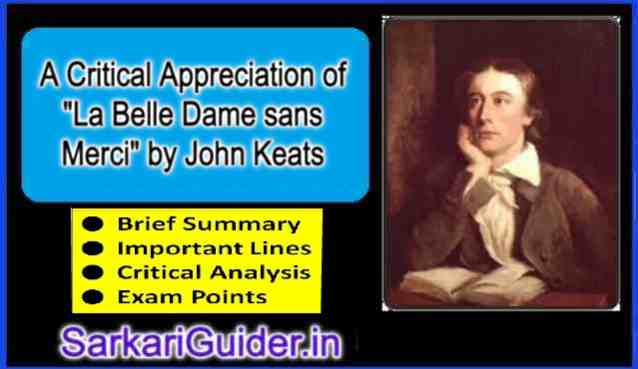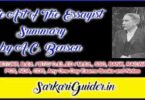A Critical Appreciation of “La Belle Dame sans Merci”

A Critical Appreciation of “La Belle Dame sans Merci” by John Keats
Give critical appreciation of ‘La Belle Dame Sans Merci” composed by John Keats?
A. Introduction The poem was written in April 1819 and published in ‘The Indicator’ on 10th May, 1820. The title of the poem is not English. Here was an English Translation of this poem and it was attributed to Chaucer. The title fascinated Keats’s fancy and in the ‘Eve of St. Agnes’ he makes Lorenzo waken Madeline by playing beside her bed.
“An ancient ditty, long since
In province call’d La Belle Dame Sans Merci!”
Central Ideas – A pale and withered knight was wandering on the bank of a lake in the mid-summer. His look were haggard. His face was pale and bloodless while there was as red flush of fever on his cheeks. The poet asked him the reason of his miserable condition. In reply the Knight told that once he happened to come across a lady in the valley. She was the daughter of a fairy, she possessed long hair nimble face and charming eyes. He made some ornaments of flowers which she gladly accepted. She fell in love with the knight delighted him with her songs. She offered hm sweet honey to take and then set out on journey by sitting on the back of a horse beside the Knight. She was closely attached to him while on journey she sang beautiful songs. Once the lady was with tears in her eyes but the Knight consoled her with his kisses. She lulled him asleep. The Knight dreamt a dream in his sleep. He saw princes, Kings and fighters. They were seen with open mouths. They all warned him against becoming a slave of the woman. He was then awake and found himself alone on the cold side of hills at such a time when lake went dry and birds did not sing.
Critical Estimate – 1. In the opinion of the some critics it is Keats’s best piece among all his works. 2. As a matter of fact the poem ‘is curiosiy imitative, and the sentiment iš strained and forced. 3. The beauty of the ballad lies in the atmosphere that has been created by the poet’s imaginative powers. 4. Suggestiveness of Keats’s power of description is remarkable. The desolate picture of late autumn, Knight’s infatuation, the warning given to the knight against the lady, pale and lonely Knight wandering on the hill are the instances of suggestiveness which has its distinct literary value. 5. La Belle Dame Sans Merci is an allegorical poem. 6. Romantic temperament of the period has been reflected in this song. Wer’d beauty, haunting music, tone of causeless melancholy are indicature of the contemporary romantic spirit. 7. Symbolic suggestion is a another hallmark of this poem Sidney Colvin remarks “In this ballad every reader must feel how truelly the imagery expresses the passion, how powerfully throw these fascinating old world symbols, the universal heart of man is made to speak.” 8. The same critic continues. “The lady of the poem has been identified in turn with poetry : art, nature, love and beauty.”
Literary Beauty – The poem is a significant piece of literary art. It is the masterpiece of Keats. Sidney Coivin remarks, “To many readers the union of infinite tenderness with a wiered intensity, the consciseness and purity of the poetic form, the wild yet simple music of cadences, the perfect inevitable of union of sound and sense make of ‘La Belle Dams Sans Merci’ the masterpiece. The words and phrases like ‘palely loiterint’ woe begone and a lily on the brow’ impart suggestive beauty.”
Universal Philosophy – This is a poem of impression. The impression is immediate, final and permanent. The theme, the phantom woman whose love is death, is almost as old as the world. Thousand of poems have been produced upon it.
Autobiographical Elements – Keats’s love for Fanny Brawne seems to have been reflected in this song. It known that his fatal illness stood in his way of union with the lady. A spirit of that sort news through the lines of the present poem.
Conclusion – The poem is, therefore, an allegory of the glamour of sex and of the tragic folly of man. Keats makes us see the wickedness of woman through the eyes of the bewitched Knight and we naturally sympathies with him.
Important Links
- John Keats Biography
- Percy Bysshe Shelley Biography
- William Wordsworth as a Romantic Poet
- William Wordsworth as a poet of Nature
- William Wordsworth Biography
- William Collins Biography
- John Dryden Biography
- Alexander Pope Biography
- Metaphysical Poetry: Definition, Characteristics and John Donne as a Metaphysical Poet
- John Donne as a Metaphysical Poet
- Shakespeare’s Sonnet 116: (explained in hindi)
- What is poetry? What are its main characteristics?
- Debate- Meaning, Advantage & Limitations of Debate
- Sarojini Naidu (1879-1949) Biography, Quotes, & Poem Indian Weavers
- Charles Mackay: Poems Sympathy, summary & Quotes – Biography
- William Shakespeare – Quotes, Plays & Wife – Biography
- Ralph Waldo Emerson – Poems, Quotes & Books- Biography
- What is a lyric and what are its main forms?






